Mulan, una historia real? / Mulan, a real story?
A propósito de mi participación
anterior en el concurso #Zipfic Microfiction challenge , cuyo tema era “mérito”, quise escribir sobre los samuráis, y me topé con varios artículos sobre mujeres samuráis, sobre los cuales basé esta publicación.
Entre las mujeres guerreras mencionadas en dichos artículos, se encontraba Hua Mulan. Sí, me refiero al personaje de la película animada de Disney Mulan.
Seguramente la mayoría tendrá buenos recuerdos y sentirá la emoción que esta película causa. Mulan es mi favorita porque a diferencia de los otros personajes femeninos de Disney de ese entonces, su objetivo no era encontrar el amor de su vida, o ser rescatada por un príncipe.
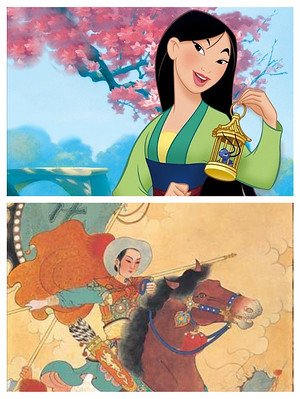
mage found on Flickr
Hua Mulan es más una leyenda que una figura histórica. Sin embargo, ha sido definiivamente una de las heroínas más populares en China y muchos creen que su historia pudo haber sido real. Hoy en día sigue siendo fuente de inspiración y símbolo de valentía y honor.
La historia de esta heroína se remonta a los siglos IV y V d.C, durante la Dinastía Wei del Norte, cuando China se encontraba con frecuencia en guerra, por lo que la mayoría de los hombres eran reclutados para pelear.
En esa época es cuando se origina la leyenda de Hua Mulan. Aunque hay muchas variaciones de su historia, el trama es casi el mismo en todos los relatos: Mulan toma el lugar de su padre haciéndose pasar por hombre (el "hijo”) para evitar que su padre enfermo fuese a la guerra donde iría a morir.
A diferencia de lo relatado en la película de 1998 de Disney, Mulan pasó más de diez años en la guerra, y no meses como en el filme. Casi todo ese tiempo estuvo escondida bajo su disfraz, incluso al liderar ejércitos.
Un día antes de una difícil batalla, se apareció vestida de mujer, lo que causó una gran impresión entre sus soldados, pero también un profundo sentimiento de admiración y respeto.
Mulan se hizo conocida por primera vez en los textos antiguos, como el poema Ballad of Mulan. Después en el siglo XVI, fue representada en obras teatrales como The Female Mulan (La Mulan femenina).
En el mundo moderno, existen muchas obras teatrales y películas sobre Mulan. La película china más reciente fue lanzada en el año 2009 y dirigida por Jingle Ma.
Y en 2020, Disney lanza la película de acción real Mulan.
Para saber detalles de la película, mira este video.
Mulan también ha sido representada en el arte y la literatura. Hay también monumentos de ella en el mundo, incluso hay un cráter de Venus que tiene su nombre.
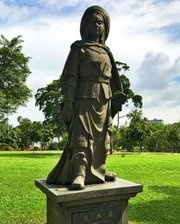
Foto de [Geordie Guy found on Flickr
Mujeres samuráis
Por otro lado, por más de ocho siglos de la historia japonesa, se han encontrado mujeres guerreras en los campos de batalla, barcos de guerra y murallas de castillos.
La existencia de mujeres guerreras ha sido comprobada gracias a investigaciones arqueológicas recientes, en las cuales se han descubiertos cuerpos de mujeres en lugares de batallas, aunque son muy pocas comparadas a la cantidad de hombres.
Dichas mujeres fueron conocidas como Onna-Bugeisha, y fueron entrenadas en las artes marciales y en el uso de las armas, además de la ciencia y literatura.
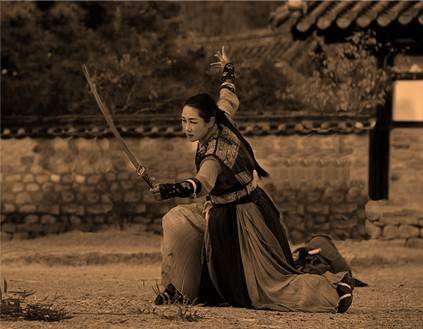
Photo by Yoo Soosang (edited), found on Unsplash
Además de los roles tradicionales de las mujeres, como ser esposas, madres o hijas, y actuar en la toma de decisiones a nivel político, las mujeres también jugaron un papel importante en la guerra.
Sus deberes, en términos de guerra, consistían principalmente en proteger y defender sus viviendas cuando los hombres iban a la guerra. Sin embargo, otras mujeres luchaban junto a los hombres en el campo de batalla.
Unas luchaban por razones religiosas o políticas, otras para vengar a sus seres queridos, y otras para sobrevivir.
En cualquier caso, es muy interesante que haya habido mujeres samuráis que pelearon tal cual lo hicieron los hombres.
Ya sea que la historia de Mulan fuese cierta o no, definitivamente es un símbolo de valentía, fuerza y honor, que permanece vivo hoy en día. Así también son las mujeres samuráis, que fueron personas reales, y que me inspiraron a escribir sobre ellas.
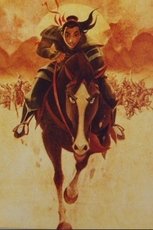
Image found on Flickr
Si quieres conocer sus historias puedes visitar este artículo (en inglés), Onna-bugeisha – The Female Samurai Warriors
Para concluir quisiera dejarles la canción inédita de presentación de la película de Disney Mulan, Loyal, Brave and True, (El mejor guerrero, en español) escrita por Jaime Hartman, Harry Gregson -Williams, Rosy Gollan Crabtree, e interpretada por Cristina Aguilera, quien también interpretó la canción principal Reflection de la peli de 1998. Su letra refleja los sentimientos de un ser sensible y a la vez aguerrido ante una situación difícil, en donde el sacrificio, la lealtad y el amor a la familia prevalecen.
SSiempre agradecida por la iinvitación de @@@rutablockchain ala comunidad de #Hive.
English version
.
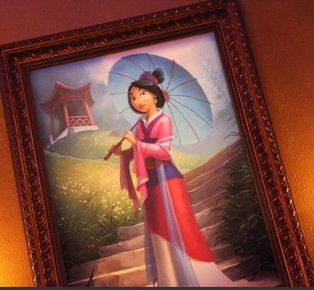
mage found on Flickr
IIn light of the prompt “merit” of the #Zapfic Microfiction challenge, in which I participated with the entry, I would like to write about warrior women based in articles I found on Samurai female warriors.
Amongst these female warrior stories, to my surprise, was the legend of Huan Mulan.
Yes, I am referring to the Disney character in the animated film Mulan,
Surely, most of you have may memories and feelings in regards to this movie. This happens to be my favorite character because, unlike most of the female characters of that time, she is neither rescued by some prince, nor looking for the love of her life.
Hua Mulan is more a legend than an historical figure. However, she is definitely one of most famous heroines in China, as she is a source of inspiration, and a symbol of bravery and wisdom.
The history of this heroine dates back to the 4th - 5th centuries A.D, during the Northern Wein Empire, when China was often at war and almost every man was recruited.
This is when the legend of Mulan was born. Though there are many variations of the story, the plot is almost the same; Mulan takes her ailing father’s place by impersonating a man (“the son”) so her father wouldn't be sent to war and die.
Mulan spent 10 years at war and not months as depicted in the film. She spent almost the entire time hidden in her custome, even when leading the army.
One day, before a dreadful battle, she showed up dressed as a woman, which caused a strong impression on her soldiers but also a deep feeling of admiration and respect.
Mulan first became known in ancient texts, such as the poem Ballad of Mulan. Then in the 16th century, she was represented in theater plays, such as The Female Mulan.
In the modern world, there are many theatre plays and films about Mulan. The most recent Chinese film was released in 2009, and directed by Jingle Ma.
There is also a new Disney movie this year, based in the Disney animated film Mulan and the poem *Ballad of Mulan, which is directed by Niki Caro and starred by Liu Yifei.
To learn details of the film check this video
She has also been represented in art and literature as well. There are also several monuments worldwide, and even a crater in Venus was named after her.
Samurai women
On another note, for more than eight centuries in Japan history, female samurai warriors were found fighting in battlefields, warships and castle walls.
The existence of female warriors has been proven thanks to archaeological investigations, in which women bodies have been found in battle locations, though they are very few when compared to men.
These women were known as Onna-Bugeisha They were trained in martial Arts and in the use of weapons.
Apart from their traditional roles as wives, daughters and mothers, and taking part in decision-making or in political processes, women also played a part in war.

Image found on Flickr
Their roles, in terms of warfare, were mainly to protect and defend the households when men departed to war, but some women also fought alongside men.
Some would fight for religious or political reasons, others to revenge their loved ones, and others just to survive.
In any case, it's very interesting that women would also fight as men did.
Whether or not the story of Mulan is true, she is a vivid symbol of courage, honor and strength.
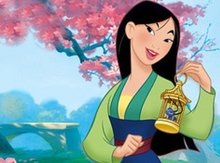
Image found on Flickr
So are the female samurai warriors who were real people, and who inspired me to write this post.
If you are interested in learning their stories you may want to read Onna-bugeisha – The Female Samurai Warriors.
I'd like to conclude this article with the new introductory song of the Disney Movie Mulan
Loyal, Brave and True written by Jaime Hartman, Harry Gregson -Williams, Rosy Gollan Crabtree, and performed by Cristina Aguilera, who also performed the main song *Reflection of the 1998 film. the lyrics reflect the feelings of a sensitive but also courageous woman before a harsh situation, where sacrifice, loyalty and the love for family prevail
Me encantó esta historia!!! Las mujeres hemos demostrado en los siglos de historia que somos valientes, guerreras, luchadoras, aguerridas, y al mismo tiempo vulnerables, dulces, cuidadoras, tantas, tantas cosas hay en nosotras 💞
Es así!
Gracias por leerme, @miriannalis :)
Desde tiempos inmemorables las mujeres más valientes han demostrado su inteligencia, y valor a pesar de las antiguas y retrógradas costumbres machistas que con los tiempos han decrecido.
Excelente e informativo post. ¡Un saludo!
Gracias, Tony!
Es así. Hay muchas historias inspiradoras y no solo en esos países sino en el mundo.
Un abrazo.
Un post que está brutal, si sabia un poco, ya que para mi ser princesa es solo para disney, pero realmente es una mujer increíble. Su historia es un ejemplo y así deberían haber más historias
Me alegra que te gustara.
También admiro su historia y la de tantas mujeres guerreras que hay en este mundo.